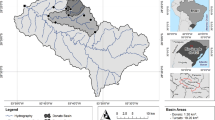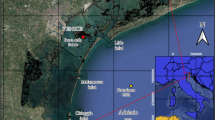Abstract
At the coastline of the Carey Island, mangroves provide natural protection against the wind-driven coastal waves. The area is located at the west Malaysia within the waters of the Straits of Malacca. Recently, its coastline has been exposed to increasing rates of coastal erosion due to mangrove deforestation. In order to provide mitigating measures, it is necessary to study wave characteristics in this region. For this purpose, we collected 5 years (2009 to 2013) of hourly measurements for wind direction, wave height, wind speed and wave period. Moreover, we used the adaptive neuro-fuzzy inference system (ANFIS) to estimate the wave period and height. The model was trained using the measured data. The validation of the model gave satisfactory R2 values of 0.8484 and 0.9496 for wave height and wave period, respectively. The findings from this study suggest that fuzzy logic based technique satisfactorily predicts the differences between multiple inputs and single output in terms of non-linear relationship. The developed model can be used to further study the effect of non-linear wind-driven waves on the depleting coastal mangrove forests in similar tropical and sub-tropical areas. We suggest further research to test the model in different geographical locations, such as in deep-ocean, narrow straits and other coastal sites, which were not covered in this study.









Similar content being viewed by others
References
Altunkaynak A, Özger M (2004) Temporal significant wave height estimation from wind speed by perceptron Kalman filtering. Ocean Eng 31:1245–1255
Alyazichi YM, Jones BG, McLean EJ (2015) Spatial distribution of heavy metal contaminations in Yowie Bay sediments and their environmental impacts. Water Resour Manag VIII 196:363
Ashton A, Murray AB, Arnoult O (2001) Formation of coastline features by large-scale instabilities induced by high-angle waves. Nature 414:296–300
Ata R, Koçyigit Y (2010) An adaptive neuro-fuzzy inference system approach for prediction of tip speed ratio in wind turbines. Expert Syst Applic 37:5454–5460
Bobba AG (2012) Ground Water-Surface Water Interface (GWSWI) modeling: recent advances and future challenges. Water Resour Manag 26:4105–4131
Buyukyildiz M, Tezel G, Yilmaz V (2014) Estimation of the change in lake water level by artificial intelligence methods. Water Resour Manag 28:4747–4763
Ching YC, Lee YH, Toriman ME, Abdullah M, Yatim BB (2015) Effect of the big flood events on the water quality of the Muar River, Malaysia. Sustain Water Resour Manag 1:97–110
Deo MC, Jha A, Chaphekar A, Ravikant K (2001) Neural networks for wave forecasting. Ocean Eng 28:889–898
Enayatifar R, Sadaei HJ, Abdullah AH, Gani A (2013) Imperialist competitive algorithm combined with refined high-order weighted fuzzy time series (RHWFTS–ICA) for short term load forecasting. Energy Convers Manag 76:1104–1116
Fernandez R, Bonansea M, Marques M (2014) Monitoring turbid plume behavior from landsat imagery. Water Resour Manag 28:3255–3269
Hashim R, Kamali B, Tamin NM, Zakaria R (2010) An integrated approach to coastal rehabilitation: mangrove restoration in Sungai Haji Dorani, Malaysia. Estuar Coast Shelf Sci 86:118–124
Healy TR (2010) Hydrodynamic modelling for mangrove afforestation at Haji Dorani, west coast peninsular Malaysia. The University of Waikato
Helfer F, Sahin O, Lemckert C, Anissimov Y (2013) Salinity gradient energy: a new source of renewable energy for Australia. proceedings of the 8th International Conference of the European Water Resources Association. EWRA, Porto
Jain P, Deo M (2006) Neural networks in ocean engineering. Ships Offshore Struct 1:25–35
Jang J-SR (1993) ANFIS: adaptive-network-based fuzzy inference system. Syst, Man Cybernet, IEEE Trans 23:665–685
Kaliraj S, Chandrasekar N, Magesh N (2014) Impacts of wave energy and littoral currents on shoreline erosion/accretion along the south-west coast of Kanyakumari, Tamil Nadu using DSAS and geospatial technology. Environ Earth Sci 71:4523–4542
Kamali B, Hashim R (2011) Mangrove restoration without planting. Ecol Eng 37:387–391
Kamranzad B, Etemad-Shahidi A, Kazeminezhad MH (2011) Wave height forecasting in Dayyer, the Persian Gulf. Ocean Eng 38:248–255
Karamouz M, Zahmatkesh Z, Goharian E et al. (2014) Combined impact of inland and coastal floods: mapping knowledge base for development of planning strategies. J Water Resour Plan Manag 04014098
Kazeminezhad M, Etemad-Shahidi A, Mousavi S (2005) Application of fuzzy inference system in the prediction of wave parameters. Ocean Eng 32:1709–1725
Khan MR, Voss CI, Yu W, Michael HA (2014) Water resources management in the Ganges basin: a comparison of three strategies for conjunctive use of groundwater and surface water. Water Resour Manag 28:1235–1250
Kim D, Grant WE, Cairns DM, Bartholdy J (2013) Effects of the North Atlantic Oscillation and wind waves on salt marsh dynamics in the Danish Wadden Sea: a quantitative model as proof of concept. Geo-Mar Lett 33:253–261
Kim S, Singh VP, Seo Y, Kim HS (2014) Modeling nonlinear monthly evapotranspiration using soft computing and data reconstruction techniques. Water Resour Manag 28:185–206
Kumar N, Feddersen F, Uchiyama Y et al. (2015) Midshelf to surfzone coupled ROMS-SWAN model data comparison of waves, currents, and temperature: diagnosis of subtidal forcings and response. J Phys Oceanog
Lee SC, Hashim R, Motamedi S et al. (2014) Utilization of geotextile tube for sandy and muddy coastal management: a review. Sci World J 2014
Mahjoobi J, Mosabbeb EA (2009) Prediction of significant wave height using regressive support vector machines. Ocean Eng 36:339–347
Makarynskyy O (2004) Improving wave predictions with artificial neural networks. Ocean Eng 31:709–724
Mason E, Pascual A, McWilliams JC et al. (2014) A first look at a new interannual ROMS solution for the Canary Basin
Masseran N, Razali A, Ibrahim K, Zin WW (2012) Evaluating the wind speed persistence for several wind stations in Peninsular Malaysia. Energy 37:649–656
Motamedi S, Hashim R, Zakaria R et al. (2014) Long-term assessment of an innovative mangrove rehabilitation project: case study on Carey Island, Malaysia. Sci World J 2014
Motamedi S, Roy C, Shamshirband S, Hashim R, Petković D, Song K-I (2015a) Prediction of ultrasonic pulse velocity for enhanced peat bricks using adaptive neuro-fuzzy methodology. Ultrasonics 61:103–113
Motamedi S, Shamshirband S, Hashim R, Petković D, Roy C (2015b) Estimating unconfined compressive strength of cockle shell–cement–sand mixtures using soft computing methodologies. Eng Struct 98:49–58
Özger M (2010) Significant wave height forecasting using wavelet fuzzy logic approach. Ocean Eng 37:1443–1451
Özger M, Şen Z (2007a) Prediction of wave parameters by using fuzzy logic approach. Ocean Eng 34:460–469
Özger M, Şen Z (2007b) Triple diagram method for the prediction of wave height and period. Ocean Eng 34:1060–1068
Petković D, Issa M, Pavlović ND, Pavlović NT, Zentner L (2012a) Adaptive neuro-fuzzy estimation of conductive silicone rubber mechanical properties. Expert Syst Applic 39:9477–9482
Petković D, Issa M, Pavlović ND, Zentner L, Ćojbašić Ž (2012b) Adaptive neuro fuzzy controller for adaptive compliant robotic gripper. Expert Syst Applic 39:13295–13304
Putri MR, Pohlmann T (2014) Lagrangian model simulation of passive tracer dispersion in the Siak Estuary and Malacca Strait. Asian J Water, Environ Pollut 11:67–74
Sabatier F (2007) US Army Corps of Engineers, Coastal Engineering Manual (CEM), Engineer Manual 1110-2-1100. US Army Corps of Engineers, Washington, DC (6 volumes) Méditerranée Revue géographique des pays méditerranéens/J Mediterranean Geography:146
Shamshirband S, Petković D, Hashim R, Motamedi S (2014) Adaptive neuro-fuzzy methodology for noise assessment of wind turbine. PLoS ONE 9(7):e103414. doi:10.1371/journal.pone.0103414
Singh R, Kainthola A, Singh T (2012) Estimation of elastic constant of rocks using an ANFIS approach. Appl Soft Comput 12:40–45
Sopian K, Othman MH, Wirsat A (1995) The wind energy potential of Malaysia. Renew Energy 6:1005–1016
Sugeno M, Kang G (1988) Structure identification of fuzzy model Fuzzy sets and systems 28:15–33
Taylor PK, Yelland MJ (2001) The dependence of sea surface roughness on the height and steepness of the waves. J Phys Oceanogr 31:572–590
Tian L, Collins C (2005) Adaptive neuro-fuzzy control of a flexible manipulator. Mechatronics 15:1305–1320
Tiang TL, Ishak D (2012) Technical review of wind energy potential as small-scale power generation sources in Penang Island Malaysia. Renew Sust Energ Rev 16:3034–3042
Toba Y, Iida N, Kawamura H, Ebuchi N, Jones IS (1990) Wave dependence of sea-surface wind stress. J Phys Oceanogr 20:705–721
Umeyama M, Nguyen DH, Minh CV, Le XR, Motani S (2014) A comprehensive approach for estimating hydraulic quantities in a multi-branched estuarine system. Water Resour Manag 28:3937–3955
Zamani A, Solomatine D, Azimian A, Heemink A (2008) Learning from data for wind–wave forecasting. Ocean Eng 35:953–962
Acknowledgments
We are thankful of the comments and suggestions from the editor and the reviewers. The authors express their sincere thanks for the funding support they received from HIR-MOHE University of Malaya under Grant No. UM.C/HIR/MOHE/ENG/34 and UM.C/HIR/MOHE/ENG/47.
Author information
Authors and Affiliations
Corresponding authors
Rights and permissions
About this article
Cite this article
Hashim, R., Roy, C., Shamshirband, S. et al. Estimation of Wind-Driven Coastal Waves Near a Mangrove Forest Using Adaptive Neuro-Fuzzy Inference System. Water Resour Manage 30, 2391–2404 (2016). https://doi.org/10.1007/s11269-016-1267-0
Received:
Accepted:
Published:
Issue Date:
DOI: https://doi.org/10.1007/s11269-016-1267-0




